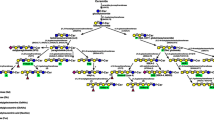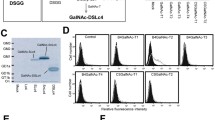Abstract
β-1,4-galactosyltransferase 1 (β1,4-GT 1) is the key enzyme transferring galactose to the terminal N-acetylglucosamine (GlcNAc) forming Galβ1→4GlcNAc structure in the Golgi apparatus. In addition, it also serves as a cell adhesion molecule by recognizing and binding to terminal GlcNAc of glycoconjugates on the adjacent cell surface and matrix through a subpopulation of the enzyme distributed on the cell surface. Transient expression of the p58GTA protein kinase, which belongs to the p34cdc2-related supergene family, could enhance β1,4-GT 1 total activity in COS cells. In this study, the p58GTA interaction with β1,4-GT 1 was confirmed using an in vitro assay with the TNT® Coupled Reticulocyte Lysate System. An expression vector containing p58GTA was stably transfected into 7721 cells, a human hepatocarcinoma cell line, expression was confirmed by Northern and Western blot analyses. The cells transfected with p58GTA (p58GTA/7721) contained 1.9 times higher total β1,4-GT 1 activity and 2.6 times higher cell-surface β1,4-GT 1 activity than the mock transfected cells (pcDNA3/7721). However, Ricinus communis agglutinin-I lectin blot analysis revealed that the enhanced β1,4-GT 1 activity did not increase the Galβ1→4GlcNAc groups on most of the membrane proteins in p58GTA/7721 cells. By flow cytometry analysis, it was found that the p58GTA/7721 cells were G2/M phase arrested, compared with the pcDNA3/7721 cells. These results suggest that the p58GTA stable transfection into human hepatocarcinoma cells could enhance the two β1,4-GT 1 subcellular pool activities independently and change its cell-cycle without modifying the β-1,4-linked galactose residues on most membrane proteins.
Similar content being viewed by others
References
Hanks SK, Quinn AM, Hunter T: The protein kinase family: Conserved features and deduced phylogeny of the catalytic domains. Science 241: 42–52, 1988
Draetta G, Beach D: Activation of cdc2 protein kinase during mitosis in human cells: Cell cycle-dependent phosphorylation and subunit rearrangement. Cell 54: 17–26, 1988
Solomon MJ, Glotzer M, Lee TH, Philippe M, Kirschner MW: Cyclin activation of p34cdc2. Cell 63: 1013–1024, 1990
Sherr CJ: Mammalian G1 cyclins. Cell 73: 1059–1065, 1993
Bunnell BA, Heath LS, Adams DE, Lahti JM, Kidd VJ: Increased expression of a 58-kDa protein kinase leads to changes in the CHO cell cycle. Proc Natl Acad Sci USA 87: 7467–7471, 1990
Xiang J, Lahti JM, Grenet J, Easton J, Kidd VJ: Molecular cloning and expression of alternatively spliced PITSLRE protein kinase isoforms. J Biol Chem 269: 15786–15794, 1994
Lahti JM, Xiang J, Kidd VJ: The PITSLRE protein kinase family. Prog Cell Cycle Res 1: 329–338, 1995
Lahti JM, Xiang J, Heath LS, Campana D, Kidd VJ: PITSLRE protein kinase activity is associated with apoptosis. Mol Cell Biol 15: 1–11, 1995
Ariza ME, Broome-Powell M, Lahti JM, Kidd VJ, Nelson MA: Fasinduced apoptosis in human malignant melanoma cell lines is associated with the activation of the p34(cdc2)-related PITSLRE protein kinases. J Biol Chem 274: 28505–28513, 1999
Dave BJ, Pickering DL, Hess MM, Weisenburger DD, Armitage JO, Sanger WG: Deletion of cell division cycle 2-like 1 gene locus on 1p36 in non-Hodgkin lymphoma. Cancer Genet Cytogenet 108: 120–126, 1999
Nelson MA, Ariza ME, Yang JM, Thompson FH, Taetle R, Trent JM, Wymer J, Massey-Brown K, Broome-Powell M, Easton J, Lahti JM, Kidd VJ: Abnormalities in the p34cdc2-related PITSLRE protein kinase gene complex (CDC2L) on chromosome band 1p36 in melanoma. Cancer Genet Cytogenet 108: 91–99, 1999
Bunnell B, Fillmore H, Gregory P, Kidd VJ: A dominant negative mutation in two proteins created by ectopic expression of an AU-rich 3' untranslated region. Somat Cell Mol Genet 16: 151–162, 1990
Bunnell BA, Adams DE, Kidd VJ: Transient expression of a p58 protein kinase cDNA enhances mammalian glycosyltransferase activity. Biochem Biophys Res Commun 171: 196–203, 1990
Shur BD, Evans S, Lu Q: Cell surface galactosyltransferase: Current issues. Glycocon J 15: 537–548, 1998
Roseman S: The synthesis of complex carbohydrates by multiglycosyltransferase systems and their potential function in intercellular adhesion. Chem Phys Lipids 5: 270–297, 1970
Furukawa K, Sato T: Beta-1,4-galactosylation of N-glycans is a complex process. Biochem Biophy Acta 1473: 54–66, 1999
Begovac PC, Hall DE, Shur BD: Laminin fragment E8 mediates PC12 cell neurite outgrowth by binding to cell surface beta 1,4 galactosyltransferase. J Cell Biol 113: 637–644, 1991
Gong X, Dubois DH, Miller DJ, Shur BD: Activation of a G protein complex by aggregation of beta-1,4-galactosyltransferase on the surface of sperm. Science 269: 1718–1721, 1995
Maillet CM, Shur BD: Perturbing cell surface beta-(1,4)-galactosyltransferase on F9 embryonal carcinoma cells arrests cell growth and induces laminin synthesis. J Cell Sci 107: 1713–1724, 1994
Hinton DA, Evans SC, Shur, BD: Altering the expression of cell surface beta 1,4-galactosyltransferase modulates cell growth. Exp Cell Res 219: 640–649, 1995
Purushotham KR, Dunn WA, Schneyer CA, Humphreys-Beher MG: A novel mechanism for isoprenaline-stimulated proliferation of rat parotid acinar cells involving the epidermal growth factor receptor and cell surface galactosyltransferase. Biochem J 284: 767–776, 1992
Appeddu PA, Shur BD: Molecular analysis of cell surface beta-1,4-galactosyltransferase function during cell migration. Proc Natl Acad Sci USA 91: 2095–2099, 1994
Asano M, Furukawa K, Kido M, Matsumoto S, Umesaki Y, Kochibe N, Iwakura Y: Growth retardation and early death of beta-1,4-galactosyltransferase knockout mice with augmented proliferation and abnormal differentiation of epithelial cells. EMBO J: 16, 1850–1857, 1997
Lu Q, Hasty P, Shur BD: Targeted mutation in beta1,4-galactosyltransferase leads to pituitary insufficiency and neonatal lethality. Dev Biol 181: 257–267, 1997
Zhang SW, Lin WS, Ying XL, Zhu D, Guo MY, Gu JX: Effect of suppression of TGF-beta1 expression on cell-cycle and gene expression of beta-1,4-galactosyltransferase 1 in human hepatocarcinoma cells. Biochem Biophys Res Commun 273: 833–838, 2000
Kijimoto-Ochiai S, Hatae T, Katagiri YU, Okuyama H: Microheterogeneity and oligosaccharide chains on the beta chains of HLA-DR, human major histocompatibility complex class II antigen, analyzed by the lectin-nitrocellulose sheet method. J Biochem 106: 771–777, 1989
Zhou DP, Jiang SM, Shen ZH, Gu JX: Effect of all-trans-retinoid acid and phorbol 12-myristate 13-acetate on the activity of human hepatocellular carcinoma cell-surface β1, 4-galactosyl-transferase. Biochem J 320: 623–625, 1996
Humphreys-Beher MG, Bunnell B, van Tuinen P, Ledbetter D, Kidd VJ: Molecular cloning and chromosomal localization of human 4-beta-galactosyltransferase. Proc Natl Acad Sci USA 83: 8918–1922, 1986
Humphreys-Beher MG: Isolation and characterization of UDP-galactose: N-acetylglucosamine 4 beta-galactosyltransferase activity induced in rat parotid glands treated with isoproterenol. J Biol Chem 259: 5797–5802, 1984
Lopez LC, Maillet CM, Oleszkowicz K, Shur BD: Cell surface and Golgi pools of beta-1,4-galactosyltransferase are differentially regulated during embryonal carcinoma cell differentiation. Mol Cell Biol 9: 2370–2377, 1989
Marchase RB, Kidd VJ, Rivera AA, Humphreys-Beher MG: Cell surface expression of 4 beta-galactosyltransferase accompanies rat parotid gland acinar cell transition to growth. J Cell Biochem 36: 453–465, 1988
Cornelis S, Bruynooghe Y, Denecker G, Van Huffel S, Tinton S, Beyaert R: Identification and characterization of a novel cell cycle-regulated internal ribosome entry site. Mol Cell 5: 597–605, 2000
Kraft AS, Wang SS, Xiang J, Pouncey L, Kidd VJ: Regulation of the p58GTA cell division control-related protein kinase during phorbol 12-myristate 13-acetate-induced terminal differentiation of U937 cells. Oncogene 7: 501–506, 1992
Wassler MJ, Shur BD: Clustering of cell surface (beta)1,4-galactosyltransferase I induces transient tyrosine phosphorylation of focal adhesion kinase and loss of stress fibers. J Cell Sci 113: 237–245, 2000
Author information
Authors and Affiliations
Corresponding author
Rights and permissions
About this article
Cite this article
Zhang, S.W., Xu, S.L., Cai, M.M. et al. Effect of p58GTA on β-1,4-galactosyltransferase 1 activity and cell-cycle in human hepatocarcinoma cells. Mol Cell Biochem 221, 161–168 (2001). https://doi.org/10.1023/A:1010932211745
Published:
Issue Date:
DOI: https://doi.org/10.1023/A:1010932211745




